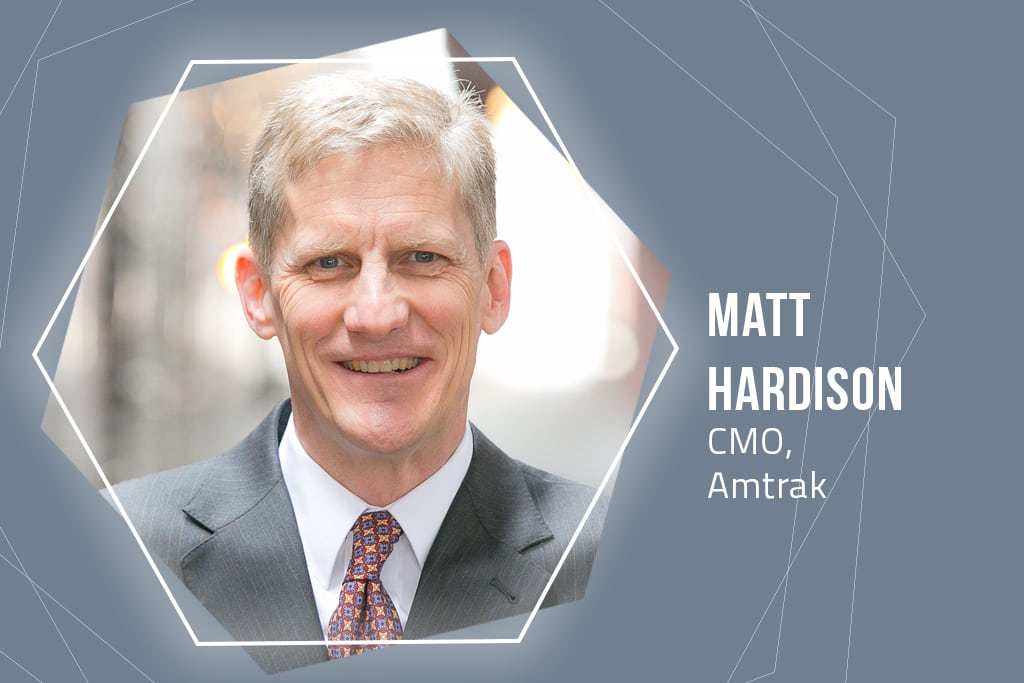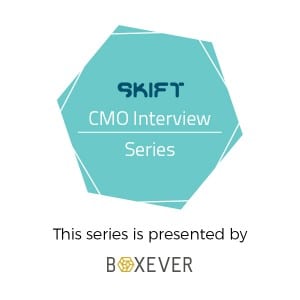Skift Take
Amtrak is looking to redefine itself into a solid leisure travel option for American travelers looking to experience the country in a different way.
Editor’s Note: Following our previous CEO interview series in online travel, hospitality, and destinations, Skift has launched a new series, this time focused on Chief Marketing Officers.
To better understand the big marketing challenges facing travel brands in an age when consumers are in control, Skift’s What Keeps CMOs Up at Night will talk with the leading voices in global marketing from across all the industry’s sectors.
These interviews with leaders of hotels, airlines, tourism boards, digital players, agents, tour operators and more will explore both shared and unique challenges they are facing, where they get insights, and how they best leverage digital insights to make smarter decisions.
This is the latest interview in the series.
Amtrak launched its first major brand campaign in 15 years last fall with the introduction of its new “500 Destinations. Infinite Stories” campaign.
By focusing on the variety of destinations Amtrak serves, the campaign has showcased how Amtrak ties together diverse U.S. destinations and operates as unique option for leisure travel in America and Canada.
Amtrak chief marketing officer Matt Hardison told Skift that Amtrak’s position in the U.S. makes it especially well-suited to meet emerging consumer trends, even as it competes against both ground and air transportation.
He discussed the design of Amtrak’s latest branding campaign, how Amtrak plans to shift its sales efforts to better reach consumers, and how a robust loyalty program is vital to capturing repeat customers.
Skift: What are the marketing challenges that keep you up at night?
Hardison: There’s no question that from a marketing and promotional standpoint that the thing that keeps me up at night is broadening the universal awareness of Amtrak outside of the Northeast corridor and getting people to try our services. We feel strongly that once you’ve tried it, you’re going to stick with us. Our research confirms this. You’re going to love train travel.
Everything we do is oriented with that in mind, whether it’s in our marketing campaign, our sales channels, what we’re doing with the next generation of our distributions systems, how we’re managing social media. It’s all oriented toward an awareness and an understanding of the value.
Skift: Last year Amtrak launched its first brand campaign in years, ‘500 Destinations, Infinite Stories.’ What went into designing the campaign, and who exactly are you trying to reach with the new marketing pieces?
Hardison: This brand campaign is really built on a couple of key insights that we have about our approach to the marketplace. Ultimately, one of the key things about Amtrak is that in the Northeast corridor we’re extremely well known and very well traveled. We have a very large presence in the Northeast.
Outside of the Northeast, even though Amtrak is extremely well known, our market research confirms that we also have a low presence when it comes to market penetration.
That’s really at the center of our whole campaign that we’ve launched back in September of ’15, which we call ‘500 Destinations, Infinite Stories.’ It’s really about showcasing why Amtrak is the smarter way to travel. We show the diversity of our services and the geographic breadth of the services. We have got more than 500 destinations nationwide. We’re in your city and providing great service around the United States.
Skift: How does social media play into Amtrak’s overall marketing effort?
Hardison: Social media is very important to us because it gives us real-time insight into what our customers are thinking and interested in. It also helps us understand ways for us to access other customers because, in a way, it’s like real-time market research. It tells you what people like or don’t like about the experience. It gives you direction on how you can improve your product and how to can communicate the value that we bring.
Skift: Amtrak is unique in the U.S. because you don’t really have any competitors in the rail space. But how do you look at your competition for passengers against air and ground travel?
Hardison: Everyone in the transportation industry competes with cars, first and foremost. That’s the number one mode of transportation in the United States by far. That’s true whether you’re a bus, or a train, or an airplane. Part of our campaign is to make people aware of Amtrak because to the extent that they’re normally stuck in congestion, they’re in traffic, they’re paying high tolls in the Northeast corridor, they’ll then find real value in riding on the train as well. That’s part of our positioning.
We do position against airplanes, against buses, of course, to sell our products to customers across all strata. What the airlines are doing is important in shaping the perceptions of what all the services might be. Of course, they can’t do everything that we can. They don’t have a café car. They don’t have big, spacious seats. They don’t have the ability to get up and walk around. Part of our strategy is to communicate the things that are really unique to rail travel.
Skift: Amtrak’s loyalty program, Amtrak Guest Rewards, was recently overhauled. How key is the program to drawing in repeat customers?
Hardison: I’m actually really excited about what we’ve been doing with loyalty for our brand. I think the loyalty program has been a very successful program for Amtrak long term, but it has not been as directly relevant as it needs to be or is as easy to understand as it needs to be to continue to grow our presence, especially outside of the Northeast corridor. In the Northeast corridor, the value proposition is comparatively straightforward and easy to understand.
It was easy to understand how to earn points in the program, but it was really complicated to understand how to redeem. If you were going on an overnight train and depending on where you were going and what class of service you were going in, and did you cross one zone into another? If you were going on a corridor train, what rules applied to that corridor was way too complicated.
Skift: When you look at generational shifts in the U.S., do you think that it’s a challenge to approach younger travelers who may never have attempted rail travel before?
Hardison: That is always a challenge. You’re always looking to educate and encourage new customers to come onboard at any age. Of course, with the younger customers, we think we’ve got a bit of a competitive advantage because younger customers generally are more transit-minded and therefore more favorably inclined to give Amtrak a try.
Interestingly, attracting younger customers is something we do quite successfully, more so outside of the Northeast corridor than in the Northeast corridor. That has a lot to do with the region, the value of the services that we offer. These services are very competitively-priced services which appeal to our younger customers, our school, college-age customers, and those just entering the workforce.
Skift: From a distribution standpoint, Amtrak doesn’t have a huge presence on traditional online booking sites or metasearch sites. How do you look at waging the battle for bookings online?
Hardison: We’re testing different online tools. We do connect for our business customers with corporate account tools, through web services. We also are currently testing through Kayak.com, co-listing with them. You’ll find that if you do a search and it happens to be in one of the states that we serve, you’ll find Amtrak also popping as an option to consider.
We’re also looking at other online options. A lot of that depends upon the economics of those online options. We don’t want to get caught in the trap that some of our partners in the transportation industry are caught in, being stuck with paying very high commission fees and not controlling their distribution. For the moment, we’re more closely aligned in distribution strategy with Southwest Airlines, for example, than maybe United Airlines.
In January, we’re going to relaunch the website completely together with all of our other sales channels. We’re going to have a much more integrated system with Amtrak guest rewards, linked across all platforms, whether it’s in the station, in the contact center, Amtrak.com, anywhere that we’re dealing with you directly. It will have better information about you and you’ll have more options to change and to add additional services for your trip.
This series is presented by Boxever. The Skift content team maintains complete editorial control over these interviews and the selection of subjects.
For more insights from Boxever, please see the following reports:
The Daily Newsletter
Our daily coverage of the global travel industry. Written by editors and analysts from across Skift’s brands.
Have a confidential tip for Skift? Get in touch
Tags: amtrak, cmo series

